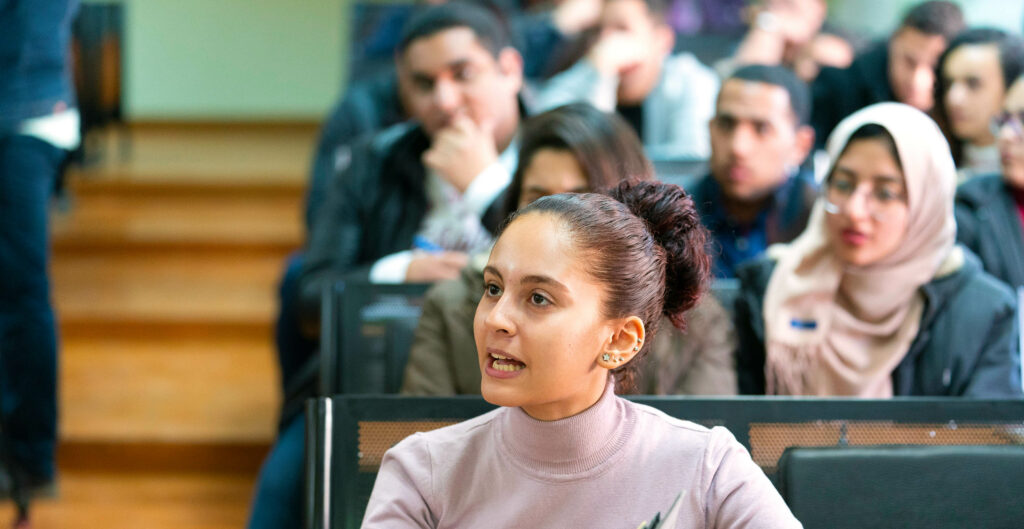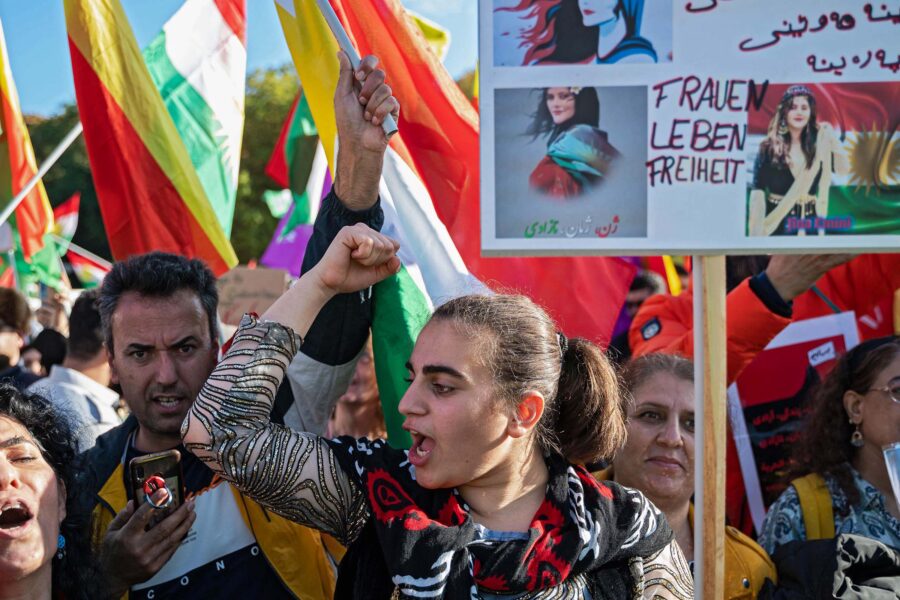Toward women’s economic empowerment in MENA
While tentative steps are being made across the region, reforms must go further and faster – from improving maternity provision to training more women in jobs traditionally reserved for men
Gender — Middle East and Northern Africa

The problem and puzzle of low female labor-force participation (FLFP) in the Middle East and North Africa (MENA) has long preoccupied scholars. FLFP rates vary but the regional average is just 21%, according to the World Bank. In most countries, women outnumber men in pursuing university degrees, with high rates of female graduates of science, technology, engineering, and mathematics (STEM) subjects, but women are less likely than men to land jobs. Women with college degrees have high LFP rates, as they gravitate to professional jobs in the public and private sectors, but their unemployment rates also are high. Women with up to secondary-level schooling are far less present in the labor force proportional to their population size. Across the region, women’s representation in the business sector is limited, with women entrepreneurs constituting just 4% of the total.
The issue of MENA women’s employment cuts across gender equality themes. The presence of violence in all its forms – domestic violence and sexual harassment on the streets, on public transportation, or in the workplace – is a factor in many women’s availability for employment. In recent years, several MENA countries have adopted anti-violence-against-women legislation, but enforcement is weak. Many laws discriminate against women. Family inheritance, for example, remains unequal, with sisters and widows receiving smaller shares than male kin. Given that family wealth often forms the basis of start-up capital for entrepreneurship, such legal inequality puts women at a financial disadvantage. Only five MENA countries – Algeria, Iran, Jordan, Morocco, and Tunisia – offer paid maternity leave through the social security or social insurance system. Even so, maternity leave in Tunisia is longer in the public than the private sector. Such discrepancy, along with the reduction in the public sector wage bill across countries, can discourage women who need work–family balance. An examination of the World Bank’s Women, Business, and the Law report reveals women’s disadvantage across a range of rights.
Highly educated or well-connected women are found in government and influential sectors (such as tech, pharmaceuticals, health research, banking, and publishing), even in senior positions. In 2013, The Economist reported that 35% of internet companies in Arab countries had a female founder, compared to a global average of just 10%. But such women are exceptions to the rule of limited female employment, especially in the non-Gulf Cooperation Council countries. Moreover, women’s political representation in those MENA countries with parliamentary systems was just 17% in 2021, according to the Interparliamentary Union. Women may constitute 20% to 30% of lawyers in some countries, and there are notable examples of female members of parliament coalescing with activist women in the law and civil society to adopt women-friendly legislation (for example, Morocco in the early 2000s and Tunisia after 2011). But the absence in most countries of a critical mass of female parliamentary lawmakers may prevent the introduction of bills to improve women’s access to good jobs and working conditions. Iran’s 5% female MPs and 15% FLFP is an example.
The two-fold challenge, then, is to incentivize more women with secondary schooling or less to seek and remain in good jobs, and to bring down the unemployment rates of college-educated women.
Empowering women economically
The absence or presence of institutional supports for working mothers has been identified as a key driver of FLFP, especially pertinent to women from working-class and low-income families. In interviews in Jordan in 1996, I found that women employees stressed the need for affordable “baby care.” Economist Ipek Ilkkaracan similarly underscores the lack of work–family reconciliation measures as an important part of the explanation for low FLFP in Turkey. A 2020 UN Women study links low FLFP to the highly unequal distribution of domestic care work in the Arab states.
Ratification of International Labour Organization (ILO) convention 183 on maternity protection would be a first step toward improving the environment for working mothers and raising participation rates among low-income women. Institutionalized supports for working mothers, including subsidized pre-school facilities, would create jobs for women without university degrees and release others for labor-force participation. Statutory paid maternity leave of at least 14 weeks should be regarded as both a labor right and an employment incentive.
COVID-19 highlighted deficiencies in healthcare provisioning, as most MENA countries have few doctors and nurses per 1,000 people. Training more women for good jobs in pre-school facilities, as well as in schools generally – as teachers, nurses, social workers, cooks, cleaners, and bus drivers – would increase the supply of job-seeking women and reduce the female unemployment rate while also helping to improve healthcare delivery and outcomes. Expanding the social infrastructure by training more women for a variety of good jobs in the broad social policy domain could enhance FLFP while also providing quality care to children and families.
Because fear of workplace sexual harassment keeps many women from seeking jobs, especially in the private sector, another step would be ratification of the 2019 ILO convention 190 on violence and harassment. Laws against domestic violence and public harassment should be strengthened, and more women trained and hired to monitor and enforce the laws. The 2011 ILO convention 189 on the rights of domestic workers has been ratified by 35 countries (at time of writing), but not a single MENA country has signed – this needs to change. Similarly, national labor codes should cover domestic workers.
Some social security laws are discriminatory, providing welfare benefits to male workers and civil servants but not to their female counterparts. Male employees can receive compensation for non-working wives, whereas female employees can only do so if their husbands are deceased or suffer from an illness that does not allow them to work. Such legislation considers women as dependents rather than responsible for their families. Women workers in agriculture and especially in domestic service are exempt from labor legislation. For these reasons, sweeping legal and policy reforms are needed to provide equality in inheritance and compensatory policies and to extend labor legislation to domestic service workers.
Where unions are allowed, women syndicalists tend to be active leaders in public services’ trade unions. They should be part of social dialogues pertaining to women and work and consulted by government bodies and committees focused on implementing the country’s economic strategy or introducing initiatives such as gender budgeting. Their participation in the ILO’s annual International Labour Conference can help diffuse global norms and policy initiatives among both fellow workers and government officials. Unions generally should be consulted on matters of foreign direct investment and development assistance, to help generate good jobs as well as economic growth.
Some legal reforms have been adopted. For example:
- in Oman, passport application procedures are now equal for men and women
- Kuwait and Lebanon enacted laws protecting women from sexual harassment in employment, including criminal penalties for such conduct
- Bahrain now mandates equal remuneration for work of equal status
- the Egyptian government enacted legislation protecting women from domestic violence and to ease procedures for women’s access to credit
Yet, more sweeping legislation and action are needed to ensure women’s economic participation and rights to decent work. These could in turn shift the still-conservative attitudes across the region regarding women, work, and family in a more egalitarian direction.
The high rates of unemployment among college graduates, especially young women, may be connected to fiscal or diversification obstacles, limited trade among MENA countries, and sanctions. Overcoming them constitutes a longer-term goal for the region. In the meantime, university curricula could include requirements and opportunities for meaningful internships so that young people may acquire work experience and job skills. Ideally, “cooperative education” programs, lasting four to six months, could be established between universities and various industries in both public and private sectors, as well as international NGOs, helping students become more competitive job applicants after graduation. A good model for such “experiential education” is found at Northeastern University in Boston.
Conclusions
Many feminist scholars have critiqued instrumentalist or “use value” arguments for women’s economic and political participation and rights. And yet, much feminist scholarship also has found wide-ranging benefits: for women, households, communities, institutions, and the quality of governance. Achieving women’s economic empowerment may be “smart economics,” but it also realizes the goal of gender equality, enabling women to reach their full potential as citizens and family providers alike.





